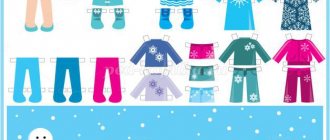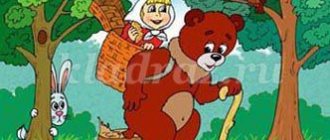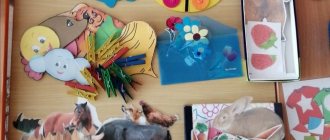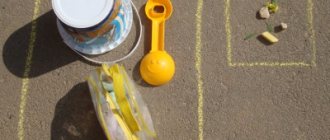Abstract of OOD on sensory development in the second group of early age
Summary of OOD on sensory development for children 2-3 years old topic “Visiting the Sun”
Goal: Continue to form ideas about shape, size and color. Tasks: - create an emotional mood; — activate the child’s speech development and vocabulary; - develop cognitive interest, fine motor skills; - learn to distinguish between the number of objects “one - many”; continue to strengthen the ability to name primary colors; - develop children’s ability to play together. Vocabulary work: mushrooms, bunny, sun. Preliminary work: observing autumn phenomena in nature while walking, looking at illustrations, reading works of art. Equipment: Toy bunny and hedgehog, 2 baskets (large and small), mushrooms, green tablecloth, cardboard plates, semolina, sun, clothespins, balloons (yellow, red, blue), cardboard house, sun medals.
Progress of the lesson
I. Organizational moment. Guys, look, we have a lot of guests today. Let's greet them, say "hello." II. Now let's say "Good morning" to our hands . Good morning, hands, are you awake? (stroke hands).
Good morning, ears, are you awake?
(stroke ears).
Good morning, little eyes, are you awake?
(stroking eyes).
Good morning legs, are you awake?
(stroking legs).
We woke up, smiled and reached for the sun.
1) Surprise moment Oh, guys, where is our sun? There is no sun, our sun is lost, and for some reason it became so sad without him. - Guys, I suggest you go on an unusual journey. In search of the sun. And what you and I will travel on, you must now guess. Please, everyone, come to me. - Now I’ll draw what we will move on. - And you tell me what it is. (I draw with my finger on semolina). - What are these guys? (Balloons). - Yes, that's right, balls. And now each of you will draw a ball for yourself on which to go on a trip. (Children draw). — What shape is the ball? (Round). - Guys, look, your painted balls have turned into real ones. Look what color they are? (red, yellow, blue). And to make it more convenient for us to hold on, each ball has ribbons in the same color as the ball. Choose any ribbon for yourself, and we’ll go. (The song “Balls” plays) 2) Didactic game “one-many” - Guys, here we are, in a wonderful clearing. Look who's meeting us here. That's right, it's a hedgehog. Hedgehog, hedgehog, tell me Hedgehog, tell me, hedgehog, How can we find the sun? How can we all get to it? — Guys, the hedgehog says that he will definitely tell you where the sun is hiding. Only we must help him collect mushrooms in baskets. Shall we help? Yes! Oh, how many mushrooms grow here. Look at the mushrooms of different sizes. This is a big mushroom, and this is (answers). That's right, it's a small mushroom. We have two baskets, one is a basket (large) and the other (small). We will collect large mushrooms in a large basket, and small mushrooms in a small basket. How many mushrooms are in the baskets? (A lot of). How many mushrooms do we have? (None) Well done guys, you helped the hedgehog. And he told us where to go next. Well, are we going? The legs began to walk, top-to-top, right along the path, top-to-toe! 2) Game “Color and Shape” - Oh, guys, where should we go next? After all, there is a river ahead. How can we get through and get around the water? And I think I know who will help us. Look who's hiding behind the Christmas tree. Let's ask him. Bunny, bunny, tell me. Bunny, bunny, show me. How can we find the sun? How can we all get to it? - Guys, the bunny says that we are on the right path, we just need to build a bridge. And then there was a strong wind and it was destroyed. You need to put the boards in their places. Look, our river is wide, but the planks are narrow. Tell me, what color are our boards? (Red, yellow). Look how we will lay the planks. First we put down the red board, and then the yellow one. We will lay the planks evenly, plank to plank. Let's try it together. Which board will we place after the red one? (Yellow). Which one will we put after the yellow one? (Red). How many planks did we need to build the bridge (A lot). Look how smooth the bridge we have turned out to be. The bunny says thank you and offers to take us to the sun. Well, are we going? The legs walked, top-to-top, straight along the path, top-to-top! 3) Experimentation. Didactic game "Clothespins". - Guys, look, what kind of house is there? - This is probably the house where our sun lives. Let's look through the window. - Look, this is our sun, but for some reason it’s sleeping. Let's wake him up: 4) Physical education. Sun, sunshine, rise up (They show a circle with their hands)
Look out the window
(They wave their hands invitingly)
So tired of waiting for you
(They pretend to cry)
Little crumbs.
(They jump).
- The sun is waking up.
- Who is screaming under the window, who is not letting me sleep? Children:
- We are children!
- Wake up, sunshine, spring has come, and we miss your warm rays so much. — Sunny: Oh, guys, thank you for waking me up. - Sunny, why are you so sad? - Sunshine: The rays - my children - were lost Across the fields, scattered across the courtyards. - Guys, look what the sun is missing? (Luchikov). - What color are the rays of the sun (Yellow). - Let's attach some rays to the sun - yellow clothespins. - Look at the color of the clothespins here (yellow, blue). - You and I will only take yellow clothespins and attach them to the sun. - Well done guys, what a beautiful sun we have created. - What geometric figure does our sun look like? (Circle) (The teacher shows a geometric figure, a yellow circle) - What can we do with a circle? (roll or place) - Let's try (invites the children to roll the ball) - Oh, what kind of sun is it, big or small? (Big) - What color is it? (Yellow) - How many rays does the sun have? (A lot) - Look at the sun’s rays everywhere: from the side, above and below. The sun needs a lot of rays to warm everyone, the children, the grass, the flowers, and the birds. This is what kind sunshine we have. What a wonderful sunshine! All the guys were petted. So that you grow up strong, healthy and kind as the sun. And the sun gives each of you a piece of itself (those little suns). So that they will always be near you and warm you. III. Summary of the lesson - Well guys, it’s time for us to go back to kindergarten. Grab your ribbons, we're leaving. (The song “Balls” plays) - Guys, we are back in kindergarten, in our group. - Let's remember who we helped today (bunny, hedgehog, sun) - How did we help the hedgehog? (collected large and small mushrooms in baskets) - How did we help the bunny? (built a bridge from planks) - How did we help the sun? (the rays found it) Did you like our trip? I also really enjoyed our trip. Everyone was great today. IV. Sources of information 1. T.V. Bashaeva “Development of children’s perception. Shape, color, size" Moscow "Mosaic-Sintez", 2013. 2. L.A. Vartan “Sensory development of preschool children” Moscow “Mosaic-Synthesis”, 2014. 3. E.I. Udaltsova “Didactic games in the education and training of preschool children” Moscow “Vlados” 2003 4. N.E. Veraksa “FROM BIRTH TO SCHOOL” Moscow “Mosaic-Sintez”, 2014
We recommend watching:
Joint activities in an early age group. Synopsis of a lesson with children in the first year of life Synopsis of a joint educational activity for children of the 1st junior group “Winter-Winter” Complex thematic lesson in an early age group together with mothers
Similar articles:
Lesson summary for an early age group. Cockerel
Lesson summary for an early age group. Dandelion
Summary of a game developmental lesson in an early age group on the topic: Rays of the sun
Game development activity in kindergarten for children of the third year of life
Lesson summary for the first early age group on the topic: Toys
MAGAZINE Preschooler.RF
Consultation for teachers “Sensory development of young children”Hello, dear colleagues and friends!
I want to tell you about the sensory development of young children. Nowadays, parents pay very little attention to raising young children. They believe that their child will still have time, why bother the child, and in general the teacher should teach the child, in their opinion, but they have no time to study with the child at home. But how good it is that there are only a few such people! Many parents enjoy working with their children and I am very happy about this, because we educators always see how the child develops and this certainly depends on whether the children are taught at home. So, let's begin:
A child’s sensory development is the development of his perception and the formation of ideas about the external properties of objects: their shape, color, size, position in space, as well as smell and taste. The importance of sensory development in early and preschool children is difficult to overestimate. It is this age that is most favorable for improving the activity of the senses and the accumulation of ideas about the world around us.
Sensory development, on the one hand, forms the foundation of the child’s overall mental development, and on the other hand, has independent significance. Since full perception is also necessary for the mental training of a child in kindergarten, school and for many types of work.
Knowledge begins with the perception of objects and phenomena of the surrounding world. All other forms of cognition - memorization, thinking, imagination - are built on the basis of images of perception. They are the result of their processing. Therefore, normal mental development is impossible without relying on full perception.
the topic: “Sensory development of actions and standards at an early age ,” because for early children, perception is one of the main lines of mental development:
- Sensory perception and cognition of the surrounding reality is carried out by turning on a system of analyzers: (color, size of objects, hearing (human voice, sounds of music, nature, touch (impact of objects on tactile and temperature receptors), smell (various smells, tastes (sweet, sour and etc.)
- The assimilation of sensory-perceptive actions and standards is a long process, the effectiveness of which involves the active inclusion of children in cognition through comparison, establishing the similarities and differences of objects and objects in the immediate environment.
- In the course of performing play actions with didactic material, the child’s sensory experience is enriched, his perception, hand and finger movements are improved, speech, thinking, attention, and memory develop.
- Children most quickly begin to orient themselves in the size of objects, because in their immediate environment they constantly encounter large and small samples of shoes, dishes, etc. An adult uses intonation to distinguish: “a large bed and a small one - a small bed,” etc. For To facilitate familiarization with the shape, he correlates it with various objects: round - an apple, oval - an egg, etc. When familiarizing with color, an adult offers children comparisons: red - like a berry, green - like a cucumber, etc.
Objectives of sensory education
The main task of sensory education is to develop in children such skills to perceive and imagine objects and phenomena that would contribute to the improvement of the processes of drawing, design, sound analysis of words, work in nature, etc. Thus, sensory education should be carried out in inseparable connection with a variety of activities.
The greatest effect for sensory education comes from productive activities, the content and organization of which are subordinated to the tasks of mental education.
By mastering the content of a particular activity, children learn to depict in drawings more and more complex objects and phenomena, to create more and more complex structures. Their knowledge and ideas about these subjects expand and deepen, and new skills and abilities are formed. At the same time, children gain a deeper understanding of such properties of objects as size, shape, color, etc.
Any meaningful activity of children includes both simpler cognitive processes - sensory, and more complex ones - mental ones. Successful mastery of a particular activity largely depends on the improvement and development of these processes.
It should be noted that the improvement and development of sensory processes directly during activity is usually difficult. It is difficult for children to simultaneously solve several problems - to carry out the actual practical actions of designing, drawing, modeling, etc. At the same time, to perceive and analyze the object on the basis of which, for example, a building or drawing is created.
I would like to bring to your attention several games and activities that promote sensory development:
"What's rolling?"
This game will introduce your child to the shapes of objects. Organize a fun game-competition - who can roll their figurine faster to the toy gates built on the table or on the floor, and let the figures that need to be rolled be a ball and a cube. At first, the child will not care which figure to choose, but after some trials he will understand that the one who chose the ball wins. Ask your child why he chooses the ball and conclude that the ball rolls because it is round.
“Reading nursery rhymes >>.
An adult repeatedly repeats a simple poem or fairy tale. When the text is already familiar to the child, make sure he finishes the unfinished phrases and, if he doesn’t do it well, switch roles. Thus, a kind of dialogue is obtained that can captivate the child. Such activities will develop the baby’s speech and memory, which will certainly affect his intelligence.
"Compare objects".
Two toys are placed in front of the child. Ask your child to tell how these objects are similar to each other and how they are different. For example, a bunny and a bear are similar to each other in that they are fluffy, they have eyes, paws, and ears. They differ in that the bear is white and the bunny is gray; the bear is big, and the bunny is small. Subsequently, the task can be complicated - put two cars or two balls. The purpose of such exercises is to develop attention in children.
"Let's dress up the dolls".
A small child successfully becomes familiar with the size of objects by comparing similar objects of different sizes. Give him two dolls - a large and a small one - and two sets of clothes. The baby shouldn't know which one. Explain that the dolls are cold and they want to get dressed, they have mixed up their clothes, ask the child to help the dolls. If at first the child distributes it incorrectly, you should not rush to redo his work, try to explain to him that these clothes are too small for this doll, and this one is too big. Such an activity can significantly develop the child’s perception. which set of clothes does the doll own? Let him solve this problem on his own.
"Remember the picture".
For this game, you need to prepare 4-6 pictures in advance, each picture should depict some object. The game can be played as a competition between several children, or you can compete with the child to see who can remember the most pictures. The players look at the pictures for several minutes, then they are removed, and the participants take turns naming the pictures that they remember. The last person to name a picture that has not yet been mentioned wins. This game helps develop the child's memory.
"Be careful".
Children walk in a circle to the music. When the word “bunny” is spoken by the leader, they should start jumping like bunnies. For the word “horse” - depict how a horse hits the floor with its hoof. For the word “crayfish” - back away, “birds” - run in all directions with your arms spread wide, “stork” - stand on one leg. This game stimulates attention and teaches you to quickly respond to sound signals.
"Puzzles".
Before the game starts, teachers should prepare a number of riddles. You shouldn’t take very complex ones that require a lot of thought; it’s better to choose easy riddles, preferably in verse. This kind of game is best played with several children, in the form of a competition. Take turns asking the children riddles, leaving them a few minutes to think. A child who does not answer three riddles is eliminated from the game. The one who answered last wins. Games of this kind are designed to develop abstract thinking and imagination in your baby.
Dear teachers! Take my advice, as from Moidodyr:
- “Play, play, study with children in the mornings and evenings! After all, sensory (mental) development is the key to success for the development of personality today, tomorrow and forever.
| Next > |
The role of sensory development
The main tasks of sensory development of preschoolers include:
- social adaptation of children to the world around them, development of their ability to recognize their sensations and respond correctly to them;
- accumulation of information about various properties of objects (size, color, shape, texture, temperature, sound, etc.);
- development and training of vision, hearing, smell and tactile analyzer in children;
- formation in children of memory, speech, objective thinking and perception of the outside world.
Young children learn life most easily and successfully through play. In the process of education for different ages, many approaches and games are used that can interest kids. This is important for successful classes and progress in sensory education and development of preschoolers.
The main goal of sensory development is to introduce the child to the outside world and the ability to freely navigate it. Children learn to distinguish different objects from each other by weight and shape, become familiar with their texture, learn to listen and distinguish individual sounds and music, and begin to divide colors into warm and cold.
The sensory development of preschool children is represented by several periods. Among them, the periods of 1-2 years and 3-4 years of life are important.




